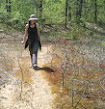The Ontario Invasive Plant Council's 2008 Annual General Meeting is Wednesday November 5th in Barrie.
The OIPC meeting comes on the heels of the Biology and Biological Control of Established Invasive Plants in Canada Conference in
Ecosystems are not only more complex than we think, but more complex than we can think. - Frank Egler
While the results of the weevils and beetles introduced to control Purple Loosestrife are a poster child for biological control agents (which BTW means not having to use chemical control in wetlands), part of the process is of course continuing to learn from the unintended impacts of releasing these controls. For one recent example, check out Bug Girl’s recent post about “Biocontrol and unanticipated consequences”.
When one tugs at a single thing in nature, he finds it attached to the rest of the world. - John Muir
Invasives Species of the Toronto Area
Where they are and how to deal with them
Tues Nov 25 2008, 7:30 PM
Presented by Paul Heydon of Grow Wild Nurseries, and Gavin Miller Head botanist for the TRCA
Part of the NANPS Winter Speaker Series
The word about invasive plants is gradually getting out. Last month, CTV reported how Calgary is facing a “biological emergency” as a result of exotic plant invasion.
Also, this past summer, the CBC reported on Dog-Strangling Vine around
However, the same stories also reported that Dog-strangling Vine “alters soil pH.”
Yikes! No it doesn't. Well, not as far anyone knows.
In response to an email from Dave Barr, Carleton University DSV researcher Naomi Cappuccino (who was interviewed for the story) replied “I haven't a clue where they got that. In fact, I tried to set them straight during the interview for TV, but that got cut. Work from Toni DiTommaso's lab at Cornell has shown that DSV has an effect on fungal communities in the soil, but as far as I know, nobody has looked at pH.”
Thank you Dave! :)
The only people I can think of who are doing any research on DSV + soil pH are Antonio Ditommaso and Lindsey Milbrath. Both are weed prof's with the Weed Ecology and Managment Lab at Cornell and neck deep in DSV research. But, they're NOT looking at whether DSV alters pH, but rather, if there are co-relations between DSV growth and populations and existing soil pH (eg click here and here too.)
One of the penalties of an ecological education is that one lives alone in a world of wounds. Much of the damage inflicted on the land is quite invisible to laymen. - Aldo Leopold, A Sand
My two fave invasive plants email lists are
Yes, they’re both out the


No comments:
Post a Comment